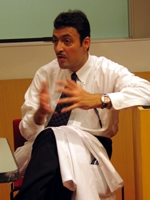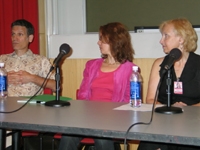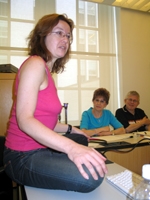"After the seminar, I hope you will all be able to take steps in the direction for a healthier life," said Dr. Mary Charlson, executive director of the Center for Complementary and Integrative Medicine.
The College's Seminar for Complementary and Integrative Medicine offered two choices out of four educational sessions, taught by leading practitioners in New York City of complementary and integrative approaches toward medicine. The two one-hour sessions were followed by a panel question-and-answer discussion in Weill Auditorium, with each expert present to answer questions on how to mitigate pain, diminish stress and promote well-being.
Dr. Bassem El-Masri, director of cardiac prevention at Weill Cornell and assistant professor of medicine, discussed the critical roles of diet and exercise in one's present and future health. He stressed that the deluge of diets washing over the nation fall into three broad categories: high-fat, high-protein and low-carbohydrate (Atkins and South Beach); moderate-fat, moderate-protein, high-carbohydrate and balanced-nutrient (such as Weight Watchers, DASH, and USDA food guidelines); and low-fat, high-carbohydrate and moderate-protein (Dean Ornish). Any diet has the potential to make you slim down, Dr. El-Masri said, but the only sure way to lose weight is through decreased caloric intake and increased energy expenditure - maintaining the diet beyond its initial stages.

Dr. Bassem El-Masri discusses his strategy of prevention through diet and exercise.
"You must keep caloric intake low, and start exercising more," he said. "Diets like Atkins will help you lose weight initially, but they're a struggle to maintain."
He also noted that new federal exercise guidelines have increased the recommended physical activity time to one hour of jogging and running per day.
He offered a delicious tip on how to raise one's "good" (HDL2) cholesterol. Toss some olive oil in your salad - just don't cook with it, or it becomes saturated. Cook with water or chicken broth instead. Dr. El-Masri has disciplined himself to eat just one meal a day with coffee two times a day, made thick with honey for complex carbohydrates. He believes in training one's body to eat less through incremental changes. One can adjust to the smaller caloric intake, he said, as a basis for a weight-loss strategy that's achievable, realistic and tailored to the individual.
Dr. Ina Becker, assistant clinical professor of psychiatry at Columbia University College of Physicians and Surgeons and psychiatrist at NewYork-Presbyterian Hospital/Columbia University Medical Center, climbed onto the counter of a chemistry lab to demonstrate how to sit cross-legged and comfortably, part of a host of tips on how to achieve a true state of meditation. Among her other tips on how to center the mind and body: sit up straight, concentrate on deep breathing, soften the gaze, and, if the mind wanders, gently bring it back to the here and now.

Dr. Robert Schulman, Dr. Ina Becker and Dr. Mary Charlson field questions at an expert panel to close the day.
"Let the repetition of the breathing instruct you, relax you," she said, to dissolve stress and invite relaxation.
Dr. Becker was too much of a pragmatist to insist upon an altered state of consciousness, one that might daunt those dipping their toes in meditation.
"You can't stop your mind from thinking completely," she said. "You can't block out or control your surroundings. Just let them flow in and out of your mind," said Dr. Becker. The soft crackle of the air conditioner and the muted voices from the adjacent room underscored her point.
Together with meditation, guided imagery - visualizing a scene, object, or image - can ease and soothe the mind. For those who can't conjure up something in the mind, she advised gazing at the flame of a candle. Or, she said, imagine a cloud of healing light, brimming with energy - breathing it in, with light suffusing the body, flowing into every cell, while all toxins, impurities and negative energy are exhaled. This imagery, like sitting up straight, can help support and guide the breath into a measured rhythm. Together, meditation and guided imagery help to decrease heart rate, lower blood pressure, and boost the immune system.
"With regular practice, people are more fulfilled and more content," Dr. Becker said. "You can put all the other nonsense in perspective, and you can learn to stress out over fewer things."
Dr. Becker cited an unexpected subterranean source of instruction: the subway.
"The subway is my favorite meditation teacher in New York," she said. "It's hot, you're waiting, the train doesn't come." But growing vexed over the train doesn't make it come any faster, she pointed out. It's an object lesson not to get attached to what is external and beyond our control - and it goes a long way toward lightening our mental burdens.
"With fewer things to aggravate about, more of you is available," Dr. Becker said. "And then, groovy things can happen."
Dr. Becker recommends 20 minutes of meditation a day - and making room for it in one's schedule, no matter how crammed.
"We must ask ourselves what is really important," Dr. Becker said. "Also, we always perform our best from a more relaxed space." Meditation, then, could pay off big-time - a decidedly productive form of decompressing.
"Everyone should re-organize his or her life to allow some space for just being," she said.
Dr. Robert Schulman, clinical assistant professor of rehabilitation medicine, gave an overview of acupuncture - a Chinese practice that's been relieving pain since 2500 B.C.
Acupuncture is not just the province of holistic healers. Some 6,000 physicians in the United States have been trained in acupuncture (especially primary care physicians, anesthesiologists, and pain management specialists). The American Academy of Medical Acupuncture offers a list of qualified practitioners available online at ![]() www.medicalacupuncture.org.
www.medicalacupuncture.org.
Acupuncture can help back, neck and knee pain, as well as sinusitis and rhinitis (hay fever) - often with dramatic results for immediate relief. But Dr. Schulman cautions not to waste money on acupuncture for weight loss, smoking cessation and drug addiction - as some (non-medical) acupuncturists like to claim.
If you fear that needles might induce pain as much as relieve it, worry not - they're almost as thin as a strand of hair, and even pets and babies can tolerate acupuncture.
Ana Sussman, R.N., also drew from ancient philosophy to discuss the benefits of yoga in releasing tension and soothing the mind through fluid movement and guided breath.
The Center, which opened its doors in June 2000, combines clinical expertise in complementary and integrative medicine with a focused research program into new strategies for the prevention and treatment of some of this country's most challenging chronic diseases.
Photos by Melissa Hantman.


